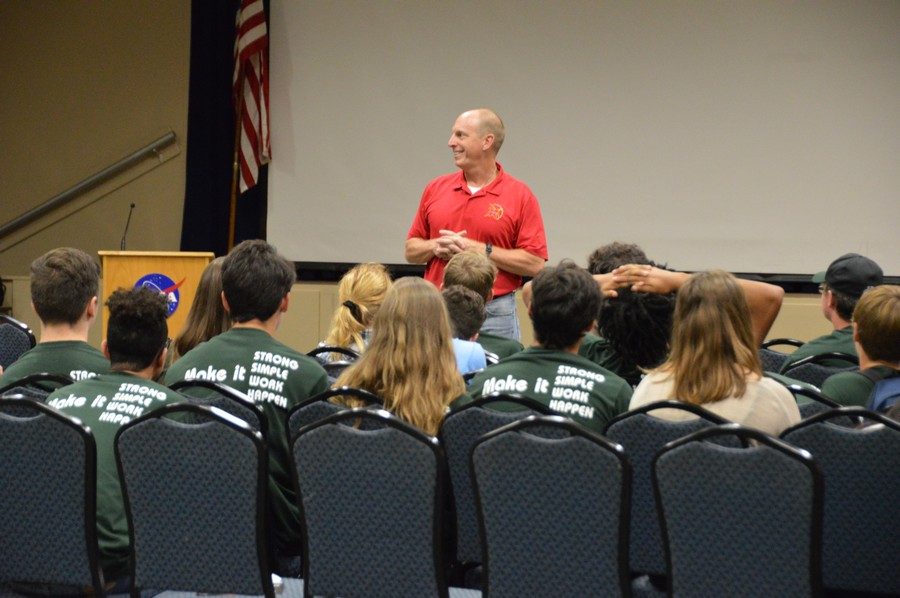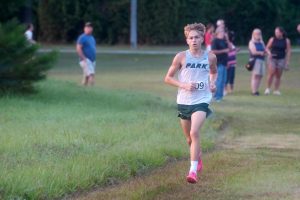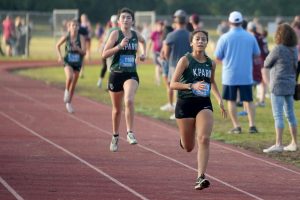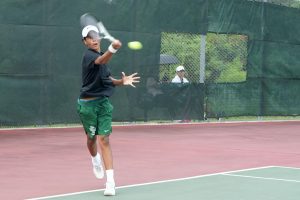Aeroscience students launch year at NASA
October 27, 2016
The big yellow school bus carrying 36 K-Park aeroscience students pulls up in an employees only parking lot at Johnson Space Center.
In front of them was a nondescript building. Nothing special to the eyes, but something special to the mind. History had been made in those four walls plastered in blue paint and murals of space exploration.
The students had been looking forward to this day for months. They were hoping to see the Saturn V rocket. They were excited about meeting an astronaut.
One by one, they collect a forest green T-shirt from a box. On the back, the shirts bear the slogan of their class:
“Make it strong.”
“Make it simple.”
“Make it work.”
“Make it happen.”
————
The trip really began in the classroom when aeroscience instructor James S Brown who’s taught at K-Park for seven years reached out to Norman Chaffee, a friend from NASA, and got his students a “NASA mission.”
This NASA mission is just one of the many things these students are doing on top of building rockets and gaining experience.
With a soft spoken, determined tone, Brown makes math and science become the cool thing to do. He doesn’t tell the students right and wrong. It’s a hands-on learning experience.
For Senior Tanner Kobal, it’s more than just a hobby. It’s a memory.
He found out a few days before the NASA visit that his grandfather had been an engineer on the rocket the students were scheduled to see.
“I really like shooting model rockets off as a kid with my dad,” Kobal said. “So I figured it would be a fun kind of nostalgic class for me to take.”
One of the high points of the class will be a chance to shoot off model rockets and a rocket designed to carry and recover a NASA moon sample retriver payload in the spring semester.
In a typical class, students walk in, go to their little teams and begin work on their rockets.
“We learn through trial and error, stuff breaks, but oh well,” Kobal said. “Time to redesign.”
It’s not just the engineering skills they need, they needed much more.
“We have to know how to be a technical team,” Brown said. “The kids have a tremendous amount to learn. It’s huge.”
———–
Speaker after speaker walked into a large room with two sets of six rows of chairs and a podium to the front left.
For the next four hours, Chaffee, Lee Graham, Anita Gale and Clay Anderson — president of the NASA Alumni League, a senior research engineer, a project manager, and an astronaut — would talk about motivation, engineering skills, respect, teamwork and real life space travel.
“You could be the smartest engineer,” said Chaffee, a former aerospace engineer. “But you would be unsuccessful if you pissed people off.”
This was just one of the many things the students from K-Park and Kingwood High School would learn to incorporate into their class of aeroscience.
Space has always intrigued Graham, even when folks in the small town he grew up in said dirt was in his blood.
“Dirt was never in my blood; space was in my blood,” Graham said. “A lot of the time it’s the same thing for these kids.”
Graham hopes to inspire motivation into the minds of students..
“The biggest thing is, is they need to follow their heart,” Graham said. “Life’s too short. Do something you want to do.”
When Anderson, the final speaker of the day, came up to the front, joy filled into the student’s’ eyes.
This was the moment they had been waiting for, the moment they had anticipated during hours of class time each day, the moment they had chattered about on the two-hour bus ride from Kingwood to Houston.
Anderson ignited enthusiasm in the room as he talked about his 157-day trip into space, even putting a bit of a twist on it.
“I flew to breakfast, then flew to work.”
“I had super strength.”
“I was faster than a bullet.”
During the Q&A session, questions and stories between students and astronaut ricocheted left and right.
“What was it like to see the earth rolling below you?” a voice shouted out of the students section.
“It was a privilege,” Anderson said. “When I watched the earth roll beneath me it was a religious experience. It takes your breath away.”
————
At the end of the day, the kids had taken in much more knowledge than before.
Brown boarded the bus and told the students:
“I was watching the speakers but I was also watching the shirts,” he said. “I would choose one green shirt over ten of the blue shirts any day.”
The students erupted into cheers and applause.
The trip to NASA had ended, but the journey had just begun.








